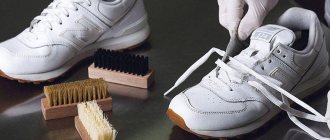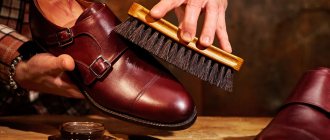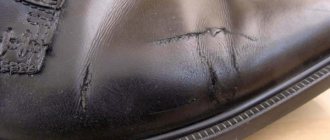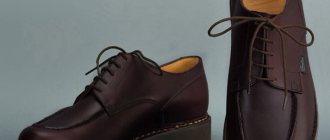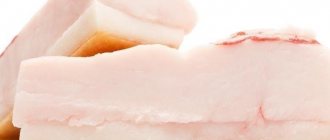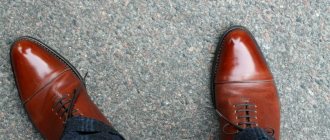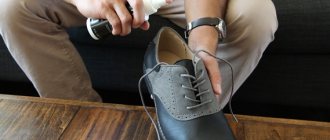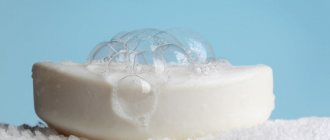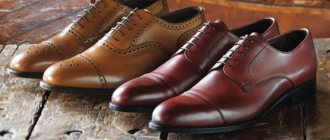This article was prepared by our beloved partners - the #GMfood - an online store of superfoods and craft eco-products.
Just for registering in the store you will receive 300 rubles to your personal bonus account and 2 more interesting gifts (Grab your gifts here)In the store's assortment you will find not only superfoods, but also healthy sweets, breakfasts, herbal teas, peanut butter, master classes for body health and facial beauty, and this is only a small part of the goodies and benefits!
Subscribe to Instagram #GMfood using this link and regularly receive new PP recipes with superfoods, see useful guides to the world of proper nutrition, and also look for gifts hidden under the link in the profile!
How to care for faux leather shoes
This article will discuss how to care for faux leather shoes.
Shoes made of artificial leather have a number of advantages:
- It costs, compared to shoes made of genuine leather, much less;
- Shoes made from high-quality synthetic materials can last a long time if they are properly cared for;
- Contrary to existing myths, such shoes conduct air well and your feet feel comfortable in them.
But any shoes, even the highest quality ones, wear out over time and become unusable.
Before deciding what products you need to care for your shoes, you need to know what material they are made of: leatherette, suede, nubuck, velor.
But in any case, you will need:
- Skin moisturizing cream;
- Paint for masking scratches and damage;
- Cream gloss;
- Shoe deodorant spray;
- Cleaner in the form of foam or gel;
- Emulsions;
- Water repellent spray;
- Brush;
- Sponge;
- Flannel napkin.
What to remember when processing leatherette
When caring for artificial leather, there are some important rules to consider. Expensive professional products are not always suitable for all types of synthetic material. First you need to establish what type it is. The technique for caring for smooth leatherette, velor, suede or nubuck is different. Widely used means:
- Cream that matches the color and moisturizes the surface.
- Dye that eliminates scratches.
- Liquid emulsions.
- Shoe gloss creams.
- Deodorizing sprays.
- Brush.
Often using water-repellent creams is not recommended, as they cause cracks in shoes.
When processing leatherette, you should not make common mistakes:
- Washing products in a washing machine and dry cleaning.
- Using products that contain acetone.
- Hot air drying. Do not leave leatherette directly on batteries. The product must be dried at room temperature. Average drying time is 20 hours.
Recommendations for shoe care
To make your shoes last as long as possible, you need to follow simple rules:
- Clean shoes from dust and dirt daily;
- When washing, do not immerse completely in water;
- Use special means;
- Dry naturally;
- Avoid exposure to hot air;
- Use water-repellent agents in slush.
The easiest way to remove dirt from leatherette shoes is to use a solution prepared from 0.5 liters of water with the addition of shampoo and whipped until foamy. First, we clean the shoes from dirt, then soak a soft cloth in the solution, wring it out and wipe the dirty areas. After this, wipe it dry. Shoes should be hung to dry to ensure even drying.
To prevent the formation of mold, shoes must be treated inside with an antiseptic.
Origin of eco-leather.
Eco-leather is a material of the 20th century. For the first time, the idea of making eco-leather crept into the minds of humanity when the issue of preserving the animal world became acute. Many wildlife activists have protested the killing of animals for leather production. At first, leatherette was used as an analogue, which could not be compared with natural fabric. Therefore, research continued until scientists from the USA and Japan introduced the whole world to a new substitute for natural leather - eco-leather. In terms of its appearance, it was difficult to distinguish eco-leather from natural leather, so it became firmly established in everyday life. After launching the production process, it was possible to significantly reduce the number of animals killed. This breakthrough in obtaining eco-leather had a positive impact on the environment, since leather production generated a lot of waste.
How to care for shoes made from synthetic materials
The main advantage of shoes made from artificial materials is that they are easy to care for, and expensive products are not needed to maintain their appearance.
Caring for leatherette shoes
You need to constantly take care of your shoes. If it is not cleaned of dust and dirt, this will cause the leather to become degreased, and it will become hard and easily wet.
The rules for caring for shoes made of any materials are the same:
- Immediately after purchase, shoes should be treated with a water-repellent spray or a special cream, which should be selected according to the color of the shoes;
- If the shoes get wet, they must be dried by stuffing them with paper;
- If white stains appear on your shoes, you can remove them with a vinegar solution;
- Clean your shoes 2-3 times a week with shoe polish. After the cream is absorbed, you need to rub it with velvet cloth to add shine;
- Dry skin can be lubricated with castor oil.
To care for leatherette shoes, it is better to use sponges soaked in silicone. Heavy stains can be easily removed with a soap solution. Glycerin will provide moisture protection.
Caring for faux suede shoes
Suede is a soft, velvety leather produced by fat and formaldehyde-fat tanning of the skins of small animals. Usually lacks a facial layer.
Source Wikipedia
Faux suede is similar to natural suede, but this material is easier to clean. It is more stain resistant, but the cleaning rules are the same as for natural suede.
Shoes should be cleaned every day if shoes are worn daily. To clean suede shoes, special brushes are sold that can be used to remove dust and small lint.
For heavily soiled areas, you can use a solution made from soap or dishwashing detergent. Lightly moisten a lint-free cloth in this solution and wipe the stains. Then blot with a dry cloth. Repeat several times until the stain is cleared.
Then we dry the shoes and raise the pile with a brush.
Caring for artificial velor shoes
Such shoes require careful care; contact with water should be avoided.
Like shoes made from other materials, they must be treated with a water-repellent spray immediately after purchase. Dirt can only be removed after it has completely dried using a stiff brush.
When washing the heel and sole, avoid getting water on the material. To remove stains, you can use a special stain remover or a regular school eraser. To remove a greasy stain, simply wipe it with a weak solution of vinegar or ammonia.
Glazed areas can be removed with steam or an eraser. A special aerosol will help make the color more saturated.
Caring for faux nubuck shoes
Artificial nubuck looks similar to natural nubuck, but is more wear-resistant. Nubuck has low moisture resistance, so such shoes must be protected from moisture and dirt. That is why this is not the best option for early spring and slushy autumn. But nubuck is not afraid of frost.
Care, again, should begin from the moment of purchase, while the material has not yet lost its properties. Even before going outside, you need to soak your shoes with a water-repellent agent to increase their wear resistance. Impregnation should be carried out in 3 approaches, each time allowing it to absorb and dry.
To care for such shoes you will need special impregnation, aerosols, and a brush that will not only remove dirt, but also preserve the fleecy surface of the shoe. It is best to buy an additional brush for cleaning heels and soles.
First, shoes need to be cleaned of dust and dirt. Then apply a spray evenly to the surface, which will protect the shoes from getting wet. If the shoes are very dirty, you need to wipe them with a sponge soaked in a solution of water and a few drops of ammonia. After this, dry well.
Can leatherette be washed?
Artificial leather does not tolerate any mechanical stress, as well as sharp and rough manipulations, and therefore requires delicate care. Washing leatherette can only be used in radical situations, with heavy soiling, and only if this type of cleaning for a particular product is provided by the manufacturer. To find out, you need to study the tag, which states the rules of care. Depending on the type of fabric and composition, some leatherette products tolerate interaction with water, others do not. If you follow the basic recommendations for this type of cleaning, the product will not deteriorate after machine or hand washing and will retain its original appearance.
How to wash white Dermantine?
Wipe the stained area with hydrogen peroxide, an aqueous solution of vinegar or citric acid, if the pigment remains. The proportions of 9% vinegar to water are the same as when using acid: one to one. After treatment, wash the leatherette with soapy water or wipe with damp cloths, dry the surface with towels.
Interesting materials:
How to enter BIOS on a Dell laptop? How to enter bios on a Lenovo laptop? How to enter the BIOS on a Toshiba laptop? How to access the boot menu on an Asus laptop? How to turn off the screen on a Dell laptop? How to turn off Fn on a Dell laptop? How to turn off the camera on a laptop? How to turn off the microphone on an Acer laptop? How to turn off an Acer laptop? How to turn off a laptop without installing updates?
Baby cream
Suitable for processing any leather products, including those with decorative elements, metal inserts, and perforations.
Rub baby cream in until completely absorbed
To soften, apply a little product to both sides of the belt and rub until completely absorbed.
If you don’t have a baby one on hand, take any moisturizing or nourishing hand or body cream without glycerin.
Read also: Where to go with children in Moscow
Types of eco-leather.
- Eco-leather on microfiber . The base is fibers coated with polyester. This material has a porous structure, has moisture-repellent properties, and most importantly, is breathable.
The appearance of eco-leather on microfiber.
- PU leather . This type of eco-leather is absolutely identical to the characteristics of natural leather, and is also not inferior to it in quality. Includes three layers: cotton fabric, discarded genuine leather and a thin, high-grade polyurethane coating.
PU leather appearance
- PVC leather . Dense, elastic, porous, tough fabric. It is made by impregnating the fibrous base with polymer compounds and applying a layer of PVC.
Appearance of PVC leather
- Perforated eco leather . A distinctive feature is the small holes that form a pattern on the canvas.
Perforated leather appearance.
- Self-adhesive . It has an adhesive base, which adds strength and increases the thickness of the material.
Appearance of self-adhesive leather
- Stretch leather . The thinnest and elastic material that stretches without cracking or damage. Includes three layers: cotton fabric coated with a polymer coating on both sides.
Stretch leather appearance.
Production of eco-leather.
For many who have had unpleasant experiences using leatherette items, eco-leather causes strong distrust and, of course, doubt about the quality of the items. I suggest you figure out what eco-leather consists of. Eco-leather is made synthetically by applying a microporous breathable film (durable and wear-resistant polyurethane) onto a cotton fabric base. A polymer is a composition of organic and inorganic compounds. It can be rubber, cellulose, polyethylene, protein elements. During operation, polyurethane does not emit toxic substances and is absolutely safe, which is why the material is called eco-leather.
Eco-leather production process.
The quality of the material depends on the thickness of the coating (the thicker the better). The thickness of the layer also depends on the intended purpose of the fabric, for example, more durable and rigid material is used for furniture, and soft and elastic for skirts and trousers. Many people have a question: “Is eco-leather genuine leather or not?” Now we can definitely answer that no! This is a new generation material obtained by spraying an artificial component.
